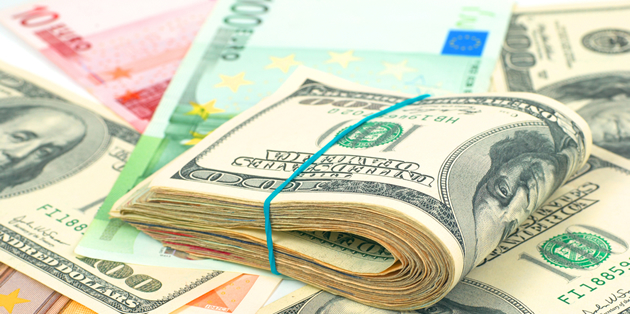- EU referendum saw victory for Brexit camp – Pound slid to multi-year lows against rivals in response
- Euro gains muted by worries over the future of the Union – Eurosceptic parties call for referendums
- Heightened safe-haven demand benefitted US Dollar – Risk aversion eclipsed impact of disappointing domestic data
- Uncertainty forecast to continue weighing on outlook of GBP exchange rates – Reluctance to trigger Article 50 set to prolong volatility
Poor US Data Fails to Boost GBP/USD Exchange Rate
Despite the latest US Services PMI holding steady on the month in June, disappointing expectations of a modest improvement, the US Dollar (USD) remained on a stronger footing on Monday. As a result the Pound to US Dollar (GBP/USD) exchange rate continued to slump, extending its losses in the region of 1.3209.
(Previously updated at 13:43 on 27/06/2016)
Both GBP/EUR and GBP/USD exchange rates were trending in the region of multi-year lows on Monday with confidence in the Pound remaining weak as markets adjust to the surprise outcome of the EU referendum.
As most polls had pointed to a victory for the ‘Remain’ campaign, the ‘Leave’ win took markets by surprise.
The Pound Euro exchange rate slid all the way to 1.19 while the Pound US Dollar exchange rate remained around a 30-year low.
Before the results of the EU referendum were known the GBP/EUR exchange rate had achieved a 3-week high of 1.31.
Pound (GBP) Continued to Slide in Aftermath of Brexit Vote
The fallout of the EU referendum has weighed heavily on the Pound (GBP) since the ‘Leave’ campaign was revealed to have claimed victory early on Friday morning. Markets had been relatively confident in the chances of the UK voting to remain within the EU in the days ahead of the referendum, prompting a sharp fall in the value of the Pound once the ultimate results became clear. Investors were naturally spooked by the implications of a Brexit, although an intervention from Bank of England (BoE) Governor Mark Carney helped to somewhat stabilise the ensuing volatility ahead of the weekend.
Chancellor of the Exchequer George Osborne emerged to offer further reassurance to the markets on Monday morning, reiterating a commitment to helping the UK economy adjust to its altered circumstances. Although Osborne also indicated his support for delaying the triggering of Article 50, this did not seem to provoke any particular rise in investor anxiety, despite the implied prolonging of economic uncertainty. With ratings agency Moody’s having already downgraded its outlook on the UK, however, volatility for the Pound and the wider economy is unlikely to significantly die down in the near future. As researchers at Goldman Sachs noted:
‘Over time, there will be additional, direct macro effects. Most notably, this includes an adverse terms of trade effect as the UK’s access to its major export markets is reduced or made more costly. Whether financial conditions tighten, and if so by how much, will also be key and these effects may go beyond what their past link with uncertainty would imply.’
Euro (EUR) Exchange Rate Outlook Muted by Referendum Uncertainty
Although safe-haven demand strengthened markedly in the wake of the EU referendum result this was of limited benefit to the Euro (EUR). While the single currency dominated the weakening Sterling, traders were nevertheless cautious of the potential spill-over impact that the vote could have on the rest of the EU. Friday also saw a disappointing slip in the finalised first quarter French GDP, which provided further evidence of the weakness already afflicting the currency union.
With Eurosceptic parties in a number of other countries, including some members of the Eurozone, already calling for their own referendums and with the ultimate future of the European project in question there has been little cause for confidence in the common currency. Concerns over the outlook of the Eurozone economy are likely to grow as long as uncertainty continues to hang over the market. As inflationary pressure had already been struggling, with the European Central Bank (ECB) running short on tools by which to stimulate the domestic economy, the Euro is likely to remain in muted spirits in the coming weeks.
Stronger US PMIs Forecast to Boost US Dollar (USD) Demand
The US Dollar (USD) trended higher against most of the majors ahead of the weekend as risk appetite sharply decreased. On Friday morning the Pound to US Dollar (GBP/USD) exchange rate slumped severely, plunging to a thirty-one year low of 1.33. Even so, with US Durable Goods Orders falling substantially short of forecast at -2.2% and the University of Michigan Confidence Index weakening, signals from the US economy do not look especially positive. Altogether this threw further doubt on the chances of the Fed being able to hike interest rates before the end of the year; a prospect that could undermine demand for the ‘Greenback’.
This afternoon’s US Services and Composite PMIs could offer some additional encouragement to the US Dollar, which remained on an uptrend at the start of the week. Even if these figures prove disappointing, however, the GBP/USD exchange rate is unlikely to make any particular recovery. A stronger showing, meanwhile, would serve to bolster the appeal of the ‘Greenback’ further, encouraging confidence in the strength of the US economy.
Current GBP, EUR, USD Exchange Rates
At the time of writing, the Pound to Euro (GBP/EUR) exchange rate was slumped around 1.2117, while the Pound to US Dollar (GBP/USD) pairing was trending lower in the region of 1.3393. Meanwhile, the Euro to US Dollar (EUR/USD) exchange rate was ceding ground at 1.1053.



